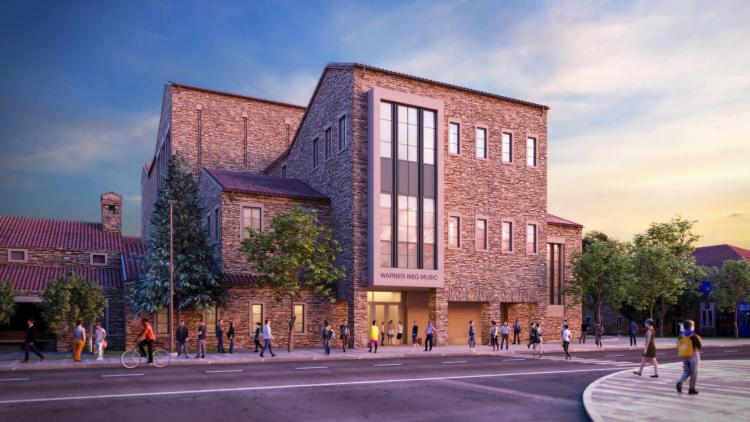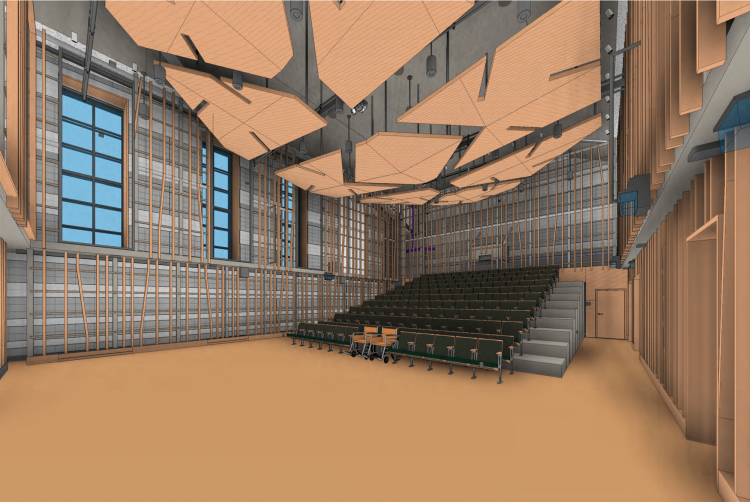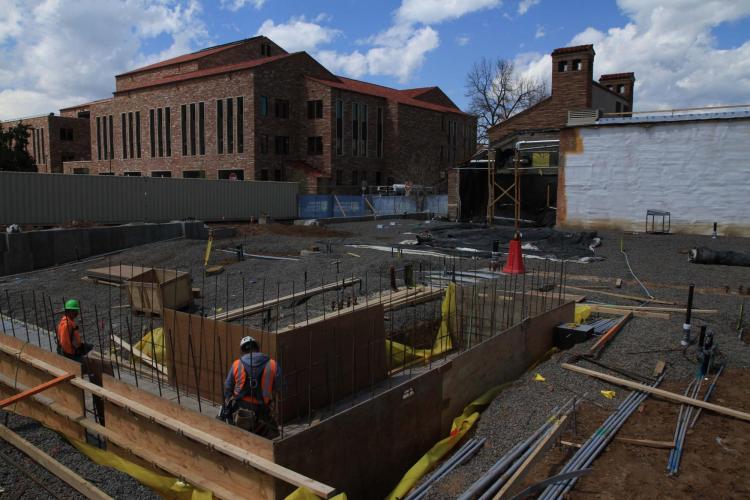A beautiful new home for music
It’s a time of transition for the College of Music. As faculty, staff and students prepare for the college’s 100th birthday in 2020, they’re working out of temporary spaces in one of the oldest buildings on campus and one of the newest, waiting for their new home to become a reality.
“But all that will be worth it, because this is going to be huge.”
Anoushka Divekar, a senior music education and clarinet double major from Iowa, is one of the students who looks forward to coming back to her alma mater after graduation to see what comes of the transition. Divekar walks past the construction on the south side of Imig Music Building every morning at 7, as she leaves her dorm room in Cheyenne Arapaho Hall to get in some practice time.
“That’s the only time I can do it. If you come looking for a practice room at 10 or 11 in the morning, you can’t find one that’s open.”
She and hundreds of music students past and present know exactly what limitations the new addition will help address. So do the faculty who work in offices without proper acoustics, ensembles that have rehearsed in the same subprime spaces for decades, the staff who play a daily game of musical chairs to schedule classes and concerts in limited spaces—and the administrators and supporters who have worked countless hours for a quarter-century to bring our physical home to the level of our artistry.
But what exactly will the 64,000-square-foot expansion bring to the College of Music? How will students, faculty, staff and patrons benefit from the $57 million construction project?
See for yourself!

A way to welcome music lovers
“The experience will leave you in awe and set the stage for the rest of your time here.” — Courtney Rowe, Assistant Dean for Advancement
One of the most striking improvements planned is the new front entrance on 18th Street. Three stories of windows, set in that trademark CU Boulder sandstone, will greet visitors just south of the current main entrance outside Grusin Music Hall.
“The first thing, your front-line experience, is with a building. So now parents and prospective students and returning alumni and visiting artists will walk in, and they’ll be met with that ‘wow,’” says Assistant Dean for Advancement Courtney Rowe. Just inside the front door, a short walk to the left, will be the college’s trademark performance space, Grusin Music Hall. To the right, a brand new, 110-seat recital hall, in the vein of the old Chamber Hall.
“Now patrons will have a front door and a welcome,” says longtime Professor of Piano and Helen and Peter Weill Faculty Fellow David Korevaar. “Our current profile doesn’t project a College of Music. This new lobby will give audiences a place to hang out before programs. It sends a much stronger message.”

A place to refine our skills
“It’s pretty cool that we’ve conceived of this large rehearsal hall as a convertible performance space with retractable seating.” — Robert Shay, Dean of the College of Music
One of the central additions planned is an innovative new large rehearsal facility that can convert into a 150-seat performance space at the push of a button. Dean Robert Shay says it will open up new opportunities for performance. “It’ll be an interesting place for performances that aren’t quite right for Grusin or the Chamber Hall.”
Scheduling ensemble rehearsals has been a sticking point for the college for years, but the new convertible space—plus dedicated choral and percussion rehearsal rooms—will mean new efficiencies and hours of freed-up time for large groups and the students who comprise them.
As the college launches initiatives inspired by The College of Music Advantage strategic plan, that need becomes even more apparent. “We’re looking forward to the opportunity to rethink the whole schedule,” Shay says.
There will also be nine additional practice rooms—a priority for students like Divekar, who regularly spends nearly her entire allotted rehearsal time looking for a space to meet with her woodwind quintet.
“Finding time for five people to meet at the same time is already impossible, and when you spend most of your time just trying to find places to practice, that has an impact on what you can do together,” Divekar says.
The expansion also adds space for the Department of Theatre & Dance, including a dance studio, changing rooms and a theatre classroom, which Shay says is indicative of the college’s move toward more on-campus collaboration.

A nurturing learning environment
“Schools around the country are getting beautiful new facilities, and those are the programs that are trying to recruit the same students and faculty that we are. And we definitely don’t always measure up.” — David Korevaar, Professor of Piano
Shay says new teaching and educational spaces were established as the focus of the expansion before he even arrived as dean in Fall 2014. “Our faculty members need the proper laboratory to do their work,” he explains. “We wouldn’t hire scientists on this campus and then put them in a closet without the equipment they need, and this is the same concept.”
To that end, two new, state-of-the-art classroom spaces and acoustically designed studios for the keyboard, woodwind and conducting faculty will replace the stretch of the south hallway that educators like Korevaar have called home for years.
“The natural light alone will make an enormous difference,” Korevaar says. “There will also be more room for the multiple pianos many of the keyboard faculty have in their studios.”
In addition, a second-floor office for the Entrepreneurship Center for Music and a top-floor suite and teaching space for the Musicians’ Wellness Program will help the college make good on one of its strategic goals of training well-rounded musicians. “It’s the first time those two important programs will have a physical space,” Shay says.
Finally, the second floor will be the home to an expanded recording studio that will further increase the college’s interdisciplinary training capabilities.
“It will be physically networked so that we can record several concerts simultaneously,” Shay explains, “but it’s also a teaching space for students who want to develop those skills alongside our talented technicians.”
A group effort
In all, the 64,000 square feet will add roughly 4,600 feet of performance space, 6,500 feet rehearsal space and 8,800 feet of teaching space, plus wider hallways, administrative offices, restrooms and more. And every one of those square feet has been a coordinated effort of passionate members of the College of Music family.
“The collective action of the Advancement team and the college’s Advisory Board has been instrumental,” Rowe says. “And Dean Shay and Dean Emeritus Daniel Sher have really carried on the legacy and vision of all the deans before them. This has been a ‘pay-it-forward’ project—the result of the effort of so many before us, those among us now, and many who will join us in the future.
“Chancellor Philip DiStefano’s leadership has been essential as well.”
Adds Shay, “I’m deeply thankful for the partnership we’ve had with CU Boulder Facilities Management. We’ve worked hand in hand with that robust component of our campus staff, and their expertise has been a big help. And we're truly fortunate to have an all-star team of external partners, especially Pfeiffer Partners and Acoustic Distinctions.”
As the college community looks out the window at the ever-changing landscape along Wardenburg Drive, the fact that the new wing is expected to open toward the tail end of the college’s year-long centennial celebration only adds to the excitement.
“We can look back with real pride and satisfaction for where we’ve been, and look ahead with anticipation as we leap forward into our second century,” Shay says.
“It’s a big birthday gift,” Divekar adds. “It’s like a present for the students.”


